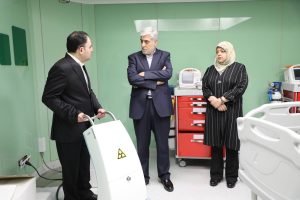
A New Era in Skin Cancer Treatment
Barekat Health & Pharmaceutical Group: Skin cancer is one of the most prevalent yet preventable malignancies worldwide. Individuals exposed to prolonged and intense sunlight are at a significantly higher risk of developing skin cancer, with basal cell carcinoma (BCC) and squamous cell carcinoma (SCC) being the most common types. However, melanoma, though less frequent, remains the deadliest form of skin cancer. Traditional treatment modalities such as surgery, radiation therapy, and chemotherapy have proven effective, but they often come with substantial side effects.
In recent years, light-based medicine (photomedicine) has emerged as an innovative and minimally invasive alternative for skin cancer treatment. This advanced approach harnesses specific wavelengths of light to selectively target and destroy cancerous cells while preserving healthy tissue.
This article explores the various applications of photomedicine in skin cancer treatment, its advantages, limitations, and future prospects.
Understanding Photomedicine & Applications in Skin Cancer Treatment
Photomedicine involves the therapeutic use of different types of light, including visible light, ultraviolet (UV) light, and infrared radiation, to diagnose and treat medical conditions. In the field of oncology, photomedicine is particularly effective in managing superficial skin cancers through techniques such as photodynamic therapy (PDT), laser therapy, and fluorescence-guided imaging.
1. Photodynamic Therapy (PDT): A Targeted Approach to Skin Cancer Treatment
Photodynamic therapy (PDT) is a cutting-edge treatment specifically designed for superficial skin cancers such as BCC and SCC. This approach employs photosensitizing agents, which are applied to or injected into the affected area and absorbed by cancer cells. Once activated by a specific wavelength of light, these agents induce a photochemical reaction that selectively destroys malignant cells while sparing surrounding healthy tissue.
Advantages of PDT:
- Precision Targeting: PDT delivers light precisely to cancerous cells, minimizing damage to adjacent healthy tissue.
- Minimal Side Effects: Unlike chemotherapy and radiation, PDT does not cause systemic toxicity, making it particularly suitable for elderly patients or those unable to tolerate aggressive treatments.
- Non-Invasive and Outpatient-Friendly: PDT does not require surgical intervention and can be performed in an outpatient setting, reducing hospital stays and recovery times.
Limitations of PDT:
- Limited Depth Penetration: PDT is primarily effective for superficial skin cancers and may not be suitable for deeper tumors.
- Multiple Sessions May Be Required: Some patients may need repeated treatments to achieve complete tumor eradication.
2. Laser Therapy: Harnessing Light Energy to Eradicate Cancer Cells
Laser therapy is another highly effective photomedicine technique for treating early-stage skin cancers and precancerous lesions. CO2 and Nd:YAG lasers are commonly used to vaporize or thermally destroy malignant cells with pinpoint accuracy.
Advantages of Laser Therapy:
- High Precision: Lasers can selectively target cancerous tissue while preserving surrounding skin.
- Minimal Bleeding and Scarring: The heat generated by laser coagulates blood vessels, reducing the risk of bleeding and promoting faster healing.
- Quick and Outpatient-Friendly: Laser therapy is usually performed as an outpatient procedure with minimal downtime.
Limitations of Laser Therapy:
- Limited Effectiveness for Deep Tumors: Like PDT, laser therapy is less effective for skin cancers that have invaded deeper layers of the dermis.
- Requires Skilled Operators: The precision of laser therapy depends on the expertise of the medical professional administering the treatment.
3. Fluorescence-Guided Imaging: Enhancing Skin Cancer Diagnosis and Treatment
Fluorescence-guided imaging is an advanced diagnostic technique that enhances the visualization of cancerous lesions. This method employs fluorescent dyes or markers that accumulate in malignant tissues, allowing dermatologists to detect cancer with greater accuracy.
Advantages of Fluorescence-Guided Imaging:
- Enhanced Diagnostic Accuracy: Enables early and precise detection of skin cancer, even in its subclinical stages.
- Minimally Invasive: Does not require biopsy or surgical intervention for preliminary diagnosis.
- Reduces Unnecessary Treatments: By accurately mapping cancerous areas, this technique prevents overtreatment of benign lesions.
Limitations:
- Limited Application for Advanced Cancers: While fluorescence imaging is excellent for early detection, it is less useful for diagnosing deep or metastatic skin cancers.
Key Benefits of Light-Based Medicine in Skin Cancer Treatment
- High Precision and Selectivity: Light-based therapies selectively target malignant cells while preserving surrounding healthy tissue.
- Reduced Side Effects: Compared to conventional therapies like chemotherapy and radiation, photomedicine minimizes systemic toxicity.
- Non-Invasive or Minimally Invasive: Many photomedicine approaches eliminate the need for surgical excision, reducing pain, scarring, and recovery time.
Challenges & Limitations
Despite its numerous advantages, photomedicine is not without challenges:
- Limited Penetration Depth: Most light-based therapies are primarily effective for superficial skin cancers and may not reach tumors located in deeper layers.
- High Cost of Equipment and Treatment: Advanced photomedicine devices and procedures may not be widely accessible in lower-resource settings.
- Requires Specialized Training: Effective implementation of light-based therapies demands skilled professionals with expertise in dermatological oncology and laser technology.
Future of Photomedicine in Skin Cancer Treatment
The future of light-based medicine is promising, with ongoing research focusing on improving its efficacy and expanding its applications. Emerging innovations include:
- Terahertz Light Technology: Offers non-invasive, high-resolution imaging to detect cancerous cells at an early stage.
- Nanoparticle-Enhanced Phototherapy: Utilizes light-sensitive nanoparticles to improve the precision and depth of treatment.
- Combination Therapies: Integrating PDT with immunotherapy or targeted drug delivery systems to enhance treatment outcomes.
As technology advances, photomedicine is expected to revolutionize skin cancer treatment, providing safer, more effective, and personalized therapeutic options.
Conclusion
Light-based medicine represents a paradigm shift in dermatologic oncology, offering highly targeted, minimally invasive, and patient-friendly alternatives to traditional cancer therapies. With ongoing technological advancements, photomedicine has the potential to significantly improve skin cancer treatment outcomes while reducing the burden of side effects associated with conventional methods.
However, further research and clinical trials are essential to refine these techniques, making them more accessible, cost-effective, and applicable to a broader range of skin cancer types. As photomedicine continues to evolve, it holds the promise of safer, more precise, and highly effective skin cancer treatments in the years to come.
-
Barkat Group specialized meeting

-
Safa Appointed as Barekat General Director

-
Barekat Health & Pharmaceutical Group at the 10th Iran Pharma Exhibition

-
Ali Safa visits Sobhan Oncology & Sobhan Darou

-
Pirsalehi & Safa visit Saman Daroo 8 Knowledge-based Company

-
Barekat Managing Director Visits Samen Pharmaceutical Company

-
Honoring Pharmacists’ Day

-
Barekat Top Executives Visiting to Barekat Hospital

